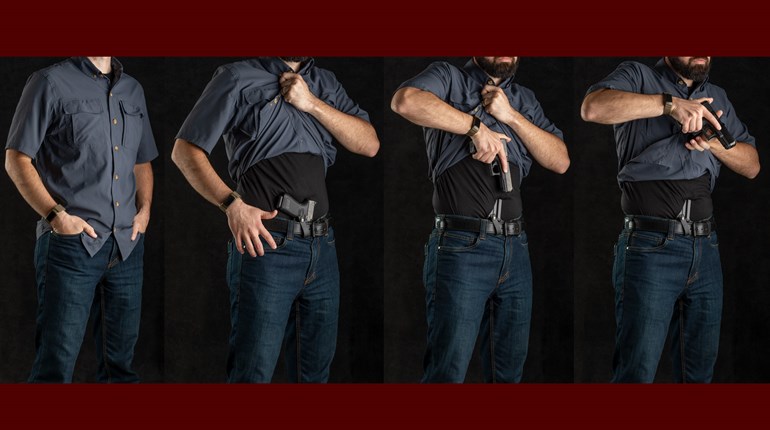
Superior long arms have been the stock in trade for generations of Remington fans, but the R51 pistol is about to elbow its way into that fine reputation in, well, short order.
This feature appears in the March ‘17 issue of NRA America’s 1st Freedom, one of the official journals of the National Rifle Association.
Given that there are whole eras—not mere decades, mind you—where the hegemony of Remingtons like the 870 shotgun or Model 700 rifle have seemed all but complete, the lack of similarly successful handguns is a bit of an enigma. A little history makes clear why, and is a little wide of our mark, but it also makes two related details clear: The paucity is not for want of trying, nor for any lack of excellent designs. If you sense a looming “however,” your instincts are good there, too. We’ve spent the last few weeks with a thoroughly modern reprise of a vintage Remington semi-automatic, and have a happy tale to tell.
Some readers will remember the slightly stormy introduction—or reintroduction, perhaps—of the R51 a couple of years ago, but that isn’t the sleek 9 mm pistol you’ll buy today. Based on a John Douglas Pedersen design dating back a century, it should not be underestimated: Only a whisker of chance and ill-timing kept it from becoming our nation’s choice of a modern semi-automatic. Reliable, accurate and soft-shooting, it was an extremely scalable pistol suitable for a wide range of calibers and tasks. As the model 53, the design was even accepted by the U.S. Navy in .45 cal., only to be thwarted by exigent wartime need for the already-available 1911.
The modern R51 builds on those original strengths, with the “Pedersen block” remaining at the heart of the handgun. The block itself is an intricate piece of engineering and machining that replaces both the breech face and locking mechanics in the slide. This permits the use of an accuracy-enhancing fixed barrel configuration, and, needing no added clearance to tilt/unlock/reload/lock, the resulting bore line is very low.

In a departure from most subcompacts looking to fill a “carry” role, all three fingers fit easily on the well-angled grip without a need for add-on pinky support. Slab-sided and advantageously “cornered,” the grip is comfortable and secure for a surprising range of hands. We’re somewhat short-thumbed and still need a slight regrip to reach the magazine release, but most won’t. That distant rumble is lefties cheering: Full-time ambi, of course, is what makes our right-side, trigger-finger fallback work for magazine swaps.
The other end of the grip has the R51’s only manual safety—the entire backstrap—and it’s one we could find no way to fool or foul. There’s just no getting “too high” and unintentionally reactivating the safety at the worst possible moment.
The too-high-on-the-grip can constitute a tactile (not tactical) oddity on the R51. If you’ve acquired the generally excellent habit of getting “high and deep” on the gun as an aid to recoil control, the first couple of shots from an R51 might have you believing the slide is biting you. This is unlikely; a very effective frame arch over the web of the hand gives all the benefits of a beavertail.

But what is going on isn’t all in your head, either. What you’re feeling is the rear edge of the grip safety channel in the frame. We got used to it in pretty short order and it never grows worse (even in a 150-round shooting session), but you don’t have to put up with it, nor be disheartened with the R51 by it. As you need only a few hundredths of an inch of clearance to avoid it altogether, just pull the gun in slightly, or raise your head. Either expedient changes hand angle sufficiently to avoid the contact. (In the long run, we won’t be surprised to see Remington break this edge a bit to eliminate even the potential for this distraction.)
Otherwise, earnest range work—to the tune of 500-plus rounds in various bullet weights—didn’t reveal any consequential flaws in the newest R51. The only hiccups of any sort occurred within the first 50 rounds, and we think at least one type was totally on us: As the Pedersen block cocks and then rides over the internal hammer, the cycling of the action acquires a sort of two-step feel. This resulted in us short-stroking the action a couple of times, and then wondering if we’d encountered an arcane feeding/cycling issue. Er, nope: Be definite when running the slide, and you’re home free. And if struggling with a compact 9 mm slide has become a familiar, unwelcome chore, you’ll bid it adieu with a R51, too. It’s .22-like once you get used to gliding by that midpoint hesitation.
Our wrap-up is easy: We’ve acquired a substantial appreciation for the R51. We grant that we like the update of Pedersen’s design more than might seem justified, but plead a point of argument: We don’t see real competitors to the R51. There are lots of good small 9 mms out there, and several excellent ones. But with only a few exceptions, these are variations on a nearly identical theme, however good. Remington’s mix of heritage, sound design and thoroughly modern methods and materials have brought a useful new choice to the small 9 mm universe—always a good thing.
Well done, Remington, very well done indeed.
SIDEBAR: Nuts And Bolts
Only a glance is necessary to see that the R51 doesn’t have a lot in common in mechanical or physical terms with most pistols in the sub-compact class. Disassembly, for instance, is quite different—“peculiar” even comes to mind—though not especially difficult. Instead, read and follow the very good manual, especially with regard to the slide lock spring, and you’ll be fine.

There’s a corollary here to the disassembly theme: We’d like to live with the Remington awhile longer to be sure, but it looks to us as though it has a high, even very high, tolerance for grime, so it will prove easy to maintain. Ours got a scrub at 200 rounds because that’s how we do it, but the detritus of the next 300-plus has created no sluggishness whatever, nor any hint of malfunction.
A final point relates to the Remington trigger, and no gilding is required: It’s a fine one. Ours measured a hair under 5 pounds, and “prepped” beautifully, but that isn’t the crucial metric. We’ve shot worse ones that were lighter, and a considerably rarer few that were better, but heavier. The nub, though, is that it’s difficult to appreciate without the other ergonomics of the R51 in play, and mainly because the pistol requires virtually no technique adjustments from full-sized guns. Just how many subcompacts can truthfully claim that?
Frank Winn has been studying arms and their relationship to tyranny, meaningful liberty and personal security all his adult life. He has also been a competitive shooter and firearms safety/shooting instructor for more than 20 years, though he won’t admit how many more than 20.


































